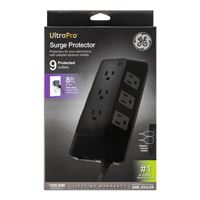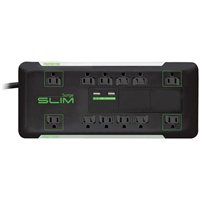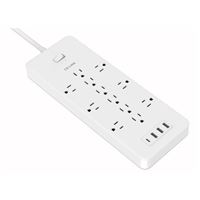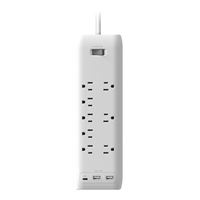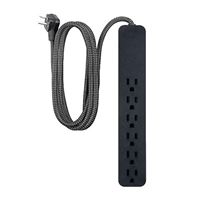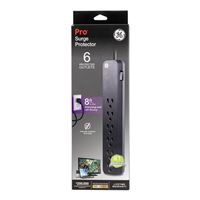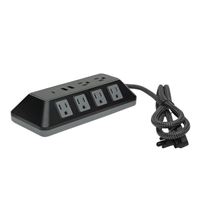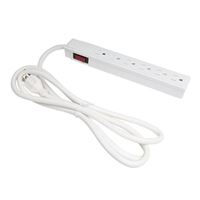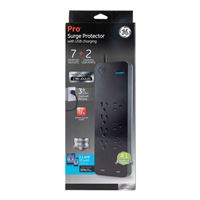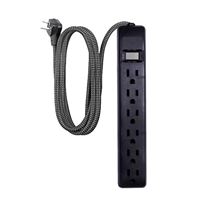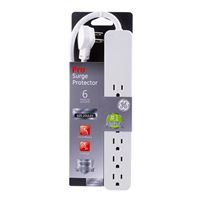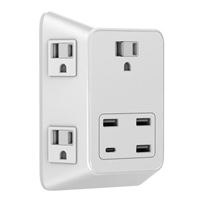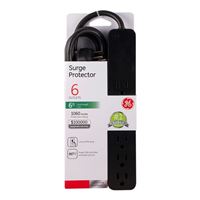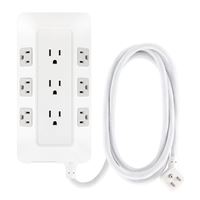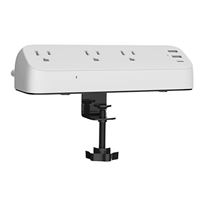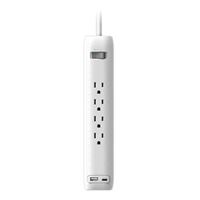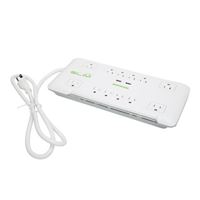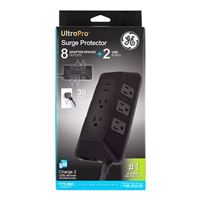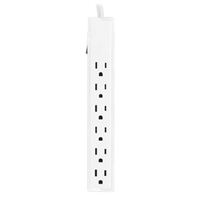Breadcrumbs
- Selected Refinements:
- Surge Suppressors, UPS Systemsx
- Surge Protectorsx
Special Offers / Advertisements
Compare up to 4 items
New list of matching products
X
Sorry, you may compare a maximum of 4 items at a time.
Please clear one or more of your compare items before adding another-
SKU: 663690
- 9 Outlets
- 2480 Joules
- 8 ft. Cable
- 9 Outlets
- 2480 Joules
- 8 ft. Cable
Usually ships in 5-7 business days.Our price $25.99 -
SKU: 407130
- 12 Outlets
- 3420 Joules
- 4 ft. Cable
- 12 Outlets
- 3420 Joules
- 4 ft. Cable
Usually ships in 5-7 business days.Our price $29.99 -
SKU: 663724
- 12 Outlets
- 3540 Joules
- 8 ft. Cable
- 12 Outlets
- 3540 Joules
- 8 ft. Cable
Usually ships in 5-7 business days.Our price $34.99 -
SKU: 437814
- 12 Outlets
- 4000 Joules
- 5 ft. Cable
- 12 Outlets
- 4000 Joules
- 5 ft. Cable
Usually ships in 5-7 business days.Our price $34.99 -
SKU: 596031
- 8 Outlets
- 2160 Joules
- 6 ft. Cable
- 8 Outlets
- 2160 Joules
- 6 ft. Cable
Usually ships in 5-7 business days.Our price $34.99 -
SKU: 663682
- 6 Outlets
- 1560 Joules
- 10 ft. Cable
- 6 Outlets
- 1560 Joules
- 10 ft. Cable
Usually ships in 5-7 business days.Our price $24.99 -
SKU: 663302
- 6 Outlets
- 1560 Joules
- 8 ft. Cable
- 6 Outlets
- 1560 Joules
- 8 ft. Cable
Usually ships in 5-7 business days.Our price $17.99 -
SKU: 663740
- 10 Outlets & 3 USB
- 3540 Joules
- 4 ft. Cable
- 10 Outlets & 3 USB
- 3540 Joules
- 4 ft. Cable
Usually ships in 5-7 business days.Our price $49.99 -
SKU: 394676
- 6 Outlets
- 201 Joules
- 6 ft. Cable
- 6 Outlets
- 201 Joules
- 6 ft. Cable
Usually ships in 5-7 business days.Our price $9.99 -
SKU: 663310
- 7 Outlets & 2 USB
- 1780 Joules
- 3 ft. Cable
- 7 Outlets & 2 USB
- 1780 Joules
- 3 ft. Cable
Usually ships in 5-7 business days.Our price $29.99 -
SKU: 663666
- 6 Outlets
- 1080 Joules
- 6 ft. Braided Cable
- 6 Outlets
- 1080 Joules
- 6 ft. Braided Cable
Usually ships in 5-7 business days.Our price $22.99 -
SKU: 663344
- 6 Outlets
- 620 Joules
- 2 ft. Cable
- 6 Outlets
- 620 Joules
- 2 ft. Cable
Usually ships in 5-7 business days.Our price $9.99 -
SKU: 663765
- 6 Outlets
- 450 Joules
- 3 ft. Cable
- 6 Outlets
- 450 Joules
- 3 ft. Cable
Usually ships in 5-7 business days.Our price $19.99 -
SKU: 438168
- 5 Outlets
- 1050 Joules
- 5 Outlets
- 1050 Joules
Usually ships in 5-7 business days.Our price $19.99 -
SKU: 663328
- 6 Outlets
- 1060 Joules
- 6 ft. Cable
- 6 Outlets
- 1060 Joules
- 6 ft. Cable
Usually ships in 5-7 business days.Our price $16.99 -
SKU: 663658
- 6 Outlets
- 540 Joules
- 6 ft. Cable
- 6 Outlets
- 540 Joules
- 6 ft. Cable
Usually ships in 5-7 business days.Our price $12.99 -
SKU: 663674
- 9 Outlets
- 2480 Joules
- 6 ft. Braided Cable
- 9 Outlets
- 2480 Joules
- 6 ft. Braided Cable
Usually ships in 5-7 business days.Our price $29.99 -
SKU: 414078
- 6 Outlets
- 201 Joules
- 6 ft. Cable
- 6 Outlets
- 201 Joules
- 6 ft. Cable
Usually ships in 5-7 business days.Our price $9.99 -
SKU: 646117
- 6 Outlets
- 201 Joules
- 4 ft. Cable
- 6 Outlets
- 201 Joules
- 4 ft. Cable
Usually ships in 5-7 business days.Our price $7.99 -
Usually ships in 5-7 business days.Our price $24.99
-
SKU: 596049
- 4 Outlets
- 1080 Joules
- 6 ft. Cable
- 4 Outlets
- 1080 Joules
- 6 ft. Cable
Usually ships in 5-7 business days.Our price $24.99 -
SKU: 394643
- 12 Outlets
- 3420 Joules
- 4 ft. Cable
- 12 Outlets
- 3420 Joules
- 4 ft. Cable
Usually ships in 5-7 business days.Our price $29.99 -
SKU: 663427
- 8 Outlets & 2 USB Ports
- 1780 Joules
- 3 ft. Cable
- 8 Outlets & 2 USB Ports
- 1780 Joules
- 3 ft. Cable
Usually ships in 5-7 business days.Our price $34.99 -
Usually ships in 5-7 business days.Our price $5.99
Special Offers / Advertisements
{
'name': 'UltraPro Turtle - Black',
'id': '676367',
'price': '25.99',
'brand': 'GE',
'category': 'Surge Protectors|564',
'list': 'Search Results',
'position': 1
},{
'name': 'Power Strip - Black',
'id': '485609',
'price': '29.99',
'brand': 'Inland',
'category': 'Surge Protectors|564',
'list': 'Search Results',
'position': 2
},{
'name': 'Turtle Surge Protector - Black/Gray',
'id': '676377',
'price': '34.99',
'brand': 'GE',
'category': 'Surge Protectors|564',
'list': 'Search Results',
'position': 3
},{
'name': 'Power Strip VPR 500 - White',
'id': '652834',
'price': '34.99',
'brand': 'Inland',
'category': 'Surge Protectors|564',
'list': 'Search Results',
'position': 4
},{
'name': 'Surge Protector Power Strip - White',
'id': '668688',
'price': '34.99',
'brand': 'Inland',
'category': 'Surge Protectors|564',
'list': 'Search Results',
'position': 5
},{
'name': 'Surge Protector - Black',
'id': '676387',
'price': '24.99',
'brand': 'GE',
'category': 'Surge Protectors|564',
'list': 'Search Results',
'position': 6
},{
'name': 'Pro Surge Protector - Black',
'id': '676344',
'price': '17.99',
'brand': 'GE',
'category': 'Surge Protectors|564',
'list': 'Search Results',
'position': 7
},{
'name': 'Surge Portector - Black',
'id': '676379',
'price': '49.99',
'brand': 'GE',
'category': 'Surge Protectors|564',
'list': 'Search Results',
'position': 8
},{
'name': 'Surge Protector - White',
'id': '648724',
'price': '9.99',
'brand': 'Inland',
'category': 'Surge Protectors|564',
'list': 'Search Results',
'position': 9
},{
'name': 'Pro Surge Protector - Black',
'id': '676345',
'price': '29.99',
'brand': 'GE',
'category': 'Surge Protectors|564',
'list': 'Search Results',
'position': 10
},{
'name': 'Surge Protector - Black',
'id': '676385',
'price': '22.99',
'brand': 'GE',
'category': 'Surge Protectors|564',
'list': 'Search Results',
'position': 11
},{
'name': 'Surge Protector - White',
'id': '676351',
'price': '9.99',
'brand': 'GE',
'category': 'Surge Protectors|564',
'list': 'Search Results',
'position': 12
},{
'name': 'Surge Protector - Black (2-Pack)',
'id': '676375',
'price': '19.99',
'brand': 'GE',
'category': 'Surge Protectors|564',
'list': 'Search Results',
'position': 13
},{
'name': 'Wall Tap Surge 5P 3UA1UC Protector - White',
'id': '652821',
'price': '19.99',
'brand': 'Inland',
'category': 'Surge Protectors|564',
'list': 'Search Results',
'position': 14
},{
'name': 'Surge Protector - Black',
'id': '676350',
'price': '16.99',
'brand': 'GE',
'category': 'Surge Protectors|564',
'list': 'Search Results',
'position': 15
},{
'name': 'Surge Protector - White',
'id': '676389',
'price': '12.99',
'brand': 'GE',
'category': 'Surge Protectors|564',
'list': 'Search Results',
'position': 16
},{
'name': 'Surge Protector- White',
'id': '676386',
'price': '29.99',
'brand': 'GE',
'category': 'Surge Protectors|564',
'list': 'Search Results',
'position': 17
},{
'name': 'Surge Protector - Black',
'id': '486071',
'price': '9.99',
'brand': 'Inland',
'category': 'Surge Protectors|564',
'list': 'Search Results',
'position': 18
},{
'name': 'SurgeGuard Basic - Black',
'id': '674354',
'price': '7.99',
'brand': 'Inland',
'category': 'Surge Protectors|564',
'list': 'Search Results',
'position': 19
},{
'name': 'Power Strip - White',
'id': '685617',
'price': '24.99',
'brand': 'Inland',
'category': 'Surge Protectors|564',
'list': 'Search Results',
'position': 20
},{
'name': 'Surge Protector Power Strip - White',
'id': '668689',
'price': '24.99',
'brand': 'Inland',
'category': 'Surge Protectors|564',
'list': 'Search Results',
'position': 21
},{
'name': 'Power Strip - White',
'id': '648723',
'price': '29.99',
'brand': 'Inland',
'category': 'Surge Protectors|564',
'list': 'Search Results',
'position': 22
},{
'name': 'UltraPro Turtle - Black',
'id': '676372',
'price': '34.99',
'brand': 'GE',
'category': 'Surge Protectors|564',
'list': 'Search Results',
'position': 23
},{
'name': '6 Outlet Surge Protector 201 Joules w/ 1.8 ft. Cord - White',
'id': '486075',
'price': '5.99',
'brand': 'Inland',
'category': 'Surge Protectors|564',
'list': 'Search Results',
'position': 24
}
{'id': 'Tower',
'name': 'Micro Center eNews Banner',
'creative': 'https://60a99bedadae98078522-a9b6cded92292ef3bace063619038eb1.ssl.cf2.rackcdn.com/webp_MCNewsST.webp',
'position': '1' }


